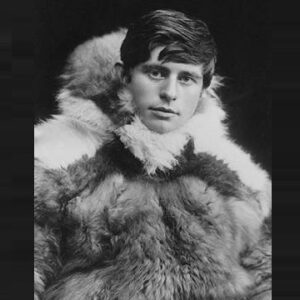Famous Danish polar explorer and anthropologist Knud Rasmussen was born in Denmark. Knud, who was raised alongside Inuit children and was born in a remote outpost in frigid Greenland, quickly learned their language and the customs of the Arctic. Rasmussen settled down to finish school and consider a more traditional life once his family left for Denmark. After a brief stint as an actor, he made the decision to embrace the spirit of the time and set out on an adventure to research the Greenlandic and Arctic indigenous populations. He came home and started travelling the nation, giving lectures and well-known talks about the Inuit people after learning their language and becoming deeply knowledgeable about their culture. He quickly developed a need to return to Greenland and, along with another arctic explorer, started a trade post in the region’s far north. He quickly started traveling all of Greenland and the wider Arctic Circle in an effort to record, memorialize, and map the culture, language, and migration patterns of the Inuit people. Rasmussen never received a formal education, but he made contributions to anthropology and arctic exploration that are respected by academic authority all over the world. He passed away having accumulated a wealth of information about the Arctic native population.
Early Childhood & Life
Greenland’s Iliussat was the place of Knud Johan Victor Rasmussen’s birth on June 7, 1879. His mother Lovise Rasmussen was a Danish-Inuit woman, and his father was a Danish missionary named Christian Rasmussen.
The two siblings of Knud. He played with Inuit kids when he was young and picked up their language, Kalaalisut. Later, his family relocated to the continent, and he attended Lynge, North Zealand, Denmark’s public school.
Career of Knud Rasmussen
Rasmussen tried in vain to make a living as an opera singer and actor between 1898 and 1900.
He set off on his first excursion in 1902, which was afterwards dubbed “The Danish Literary Expedition.” The exploration’s goal was to learn more about and record Inuit culture.
After his return to his home country in 1904, he started giving lectures regarding the expedition’s findings. Four years later, he released “The People of the Polar North,” a book on his experiences on the “Danish Literary Expedition.”
Together with his friend Peter Freuchen, he co-founded the “Thule Trading Station” at Cape York, Greenland, in 1910. Rasmussen’s seven polar voyages eventually left from the “Thule Trading Station,” which served as their launching point.
He and Freuchen set off on the “First Thule Expedition” in 1912 to see if Peary Land and Greenland were separated by a waterway. The pair successfully disproved the existence of the water channel after traversing over 1,000 kilometers of ice.
To investigate the northern coast of Greenland, Rasmussen, Freuchen, and five other men set off on the “Second Thule Expedition” in 1916. The only fatalities in Rasmussen’s career occurred during the two-year expedition, when two men perished.
He left on the “Third Thule Expedition” in 1919 to bring food and essential supplies to fellow polar explorer Roald Amundsen. Later that year, he set off on his own for the “Fourth Thule Expedition.” He spent a year traveling throughout eastern Greenland and gathering ethnographic information about the Inuits.
His exploits on the Second Thule Expedition were chronicled in the book “Greenland by the Polar Sea,” which he published in 1921. Later that year, Rasmussen began the “Fifth Thule Expedition,” a protracted five-year attempt to elucidate the Inuit peoples’ ancestry.
He wrote “Across Arctic America,” a book that described Inuit migratory patterns, in 1927.
He set off on the “Sixth Thule Expedition” in 1931. Rasmussen and his crew were charged with drawing the disputed line separating Norway and Greenland.
He set out on his seventh and final “Thule Expedition” in 1933. He unfortunately developed pneumonia following a case of food poisoning and passed away a few weeks later in Denmark.
The first person of European ancestry to travel through the Northwest Passage on a dogsled was Major Works Rasmussen. His 15 books on Inuit life, culture, and ethnic heritage make him one of the greatest experts in the field.
Recognition & Achievements
The “American Geographical Society” gave Rasmussen an Honorary Fellowship in 1912.
In 1919, the Swedish Society for Anthropology and Geography gave him the Vega Medal (SSAG).
In 1924, he received an honorary doctorate from the “University of Copenhagen” in recognition of his services to the study of the Inuit people. He received the “Daly Medal” from the “American Geographical Society” in the same year.
Personal Legacy & Life
In 1908, Knud wed his bride Dagmar Andersen. Inge Thorborg, Hanne Rasmussen, and Niels Rasmussen were their three children.
After Rasmussen’s death, a 10-volume collection of his research from the “Fifth Thule Expedition” was published. The items found during the voyage are kept in the museums in Denmark.
Factoring in its position as the world’s most northerly trading post, Cape York’s “Thule Trading Station” was given its name. The fabled frozen northern region of the world was called Thule by the Greeks.
Peter Freuchen, a longtime friend and fellow explorer of this well-known explorer, wed a Dagmar as well.
The Journals of Knud Rasmussen, a film based on his study, was released in 2006. The same year, the movie debuted at the “Toronto Film Festival.”
Knud Rasmussen Net Worth
Knud is one of the wealthiest and most well-known explorers. Knud Rasmussen’s net worth is roughly $1.5 million, according to our analysis of data from sources including Wikipedia, Forbes, and Business Insider.


